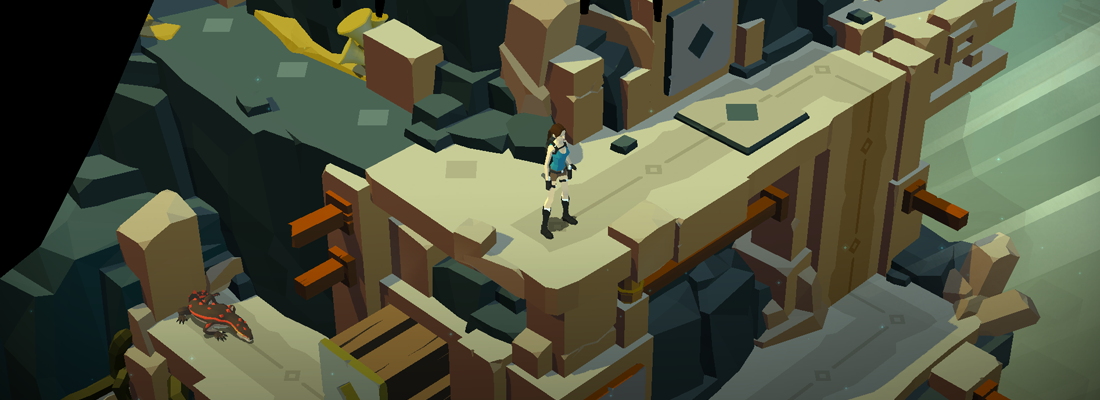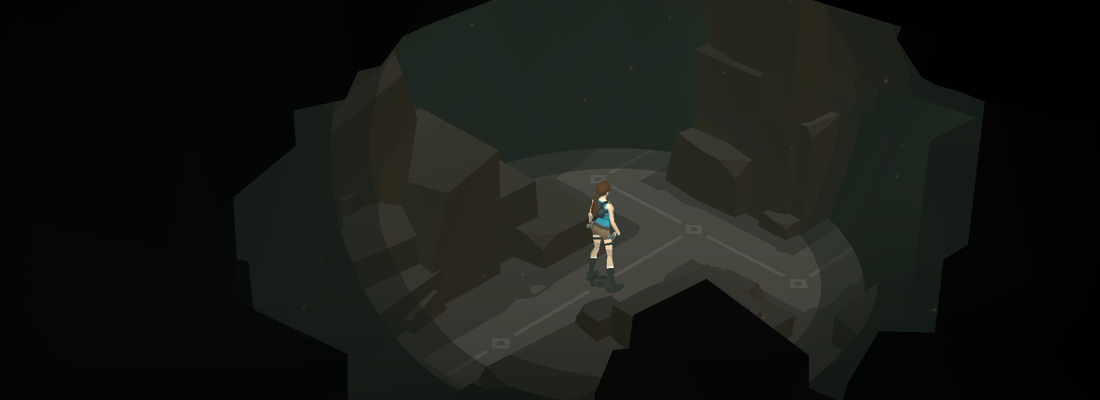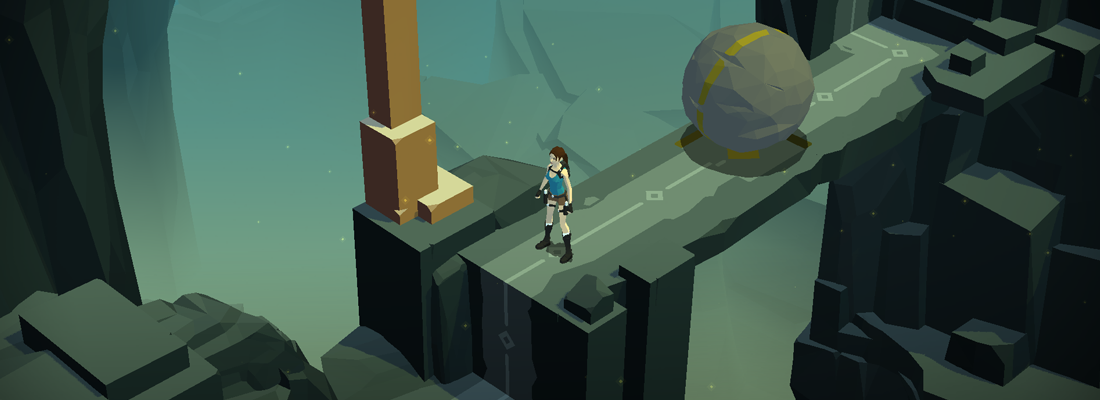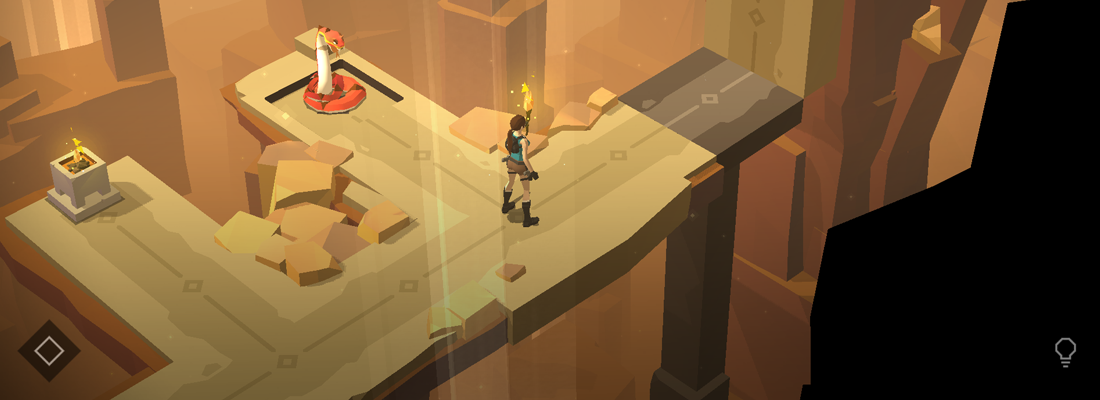[We start playing Lara Croft Go together. I run into a simple push lever mechanic early in the game.]
Routon: We introduce every mechanic in a super simple way. So the context is very simple and easy to understand. We also want the process of figuring out the mechanic to be part of the fun.
And the other thing from Hitman Go is that we had these sort of screens in the background, telling the story. Here we wanted to go strongly with non-verbal storytelling. So you can see as you move, something happens in the background. [I move Lara up a few spots on a long path. The silhouette of a giant serpent like creature rumbles through the level a little at a time as Lara takes each step.]
So there’s no long cutscene or anything that interrupts your gameplay.
GamesBeat: Yeah! Yeah. I like that. It’s … it’s just my opinion here, but it shows a strength, a confidence, at using the medium. You’re using what the medium does well, or unique, to express context. As opposed to not knowing how to use the medium to say what you want, so you’re going to throw in a bunch of. …
Routon: … like a million lines for cutscenes or …
GamesBeat: … yeah! Just let the gameplay narratively speak for itself. You know what I mean?
Routon: It’s the old l show, don’t tell.
GamesBeat: Yeah!
Routon: But it’s much harder. Because you have to make sure the story can be understood by itself. Your story has to be much simpler and more visual.
GamesBeat: Right.
Routon: And the story here, we didn’t want to just do another chapter in the Lara Croft series. It’s like a symbolic representation of all of the adventures she has had. It’s really trying to embrace the tropes and then turning those into puzzles.
GamesBeat: I notice you can’t look around with the camera like you could in Hitman Go.
Routon: No, you can’t. It’s because that’s part of the exploration. You know, there are pillars for every big franchise. I’d say for Lara, I don’t know them all by heart … but I’d say they are exploration, combat, and traversal.
And you can’t really have exploration if Lara can look everywhere you want.
GamesBeat: Hmmm?
Routon: So we fixed the camera and created this silhouette in the foreground that can block [hidden] stuff [in the middle and background]. And also, we can make sure that every screen has a nice composition.
GamesBeat: I notice there are a lot of points, or spots, that Lara has to be manually moved in some sections. Like, we’ll run into a long straight path with three or four points to move her through. How did you come to the decision to put in as many points as you did?
Routon: It depends. Like, the game is an equation. You run into this puzzle, and you want everything to be as tight as possible. So sometimes, every point is tied to that puzzle and sometimes it’s just giving the user time to [think and uncover the upcoming problems].
There’s also a story element. Like, right here … [Routon points at the screen, where I am leading Lara down a long pathway towards some gates.] … I may not want to show off that big gate right away. So for this section there may be a few more nodes [to traverse].
Now, we know it seems like extra swiping, but this is what I was talking about when it comes to storytelling. This [extra moving points] is often the exception, not the norm.
[I eventually reach a big, Indiana Jones-style boulder trap.]
Routon: So, do you remember that big boulder from the first game that follows you? So, we wanted to capture that, but we didn’t want any time pressure. Time is not a resource in our game. Just turns. So we needed to translate this [high-action moment] with a turn-based boulder. I step in one spot, the boulder moves forward one spot.
I really want to show you something [related to this concept]. Let me show you a boss fight. I won’t show you the whole boss fight, but I just want you to see … I’ll just show you the first part. [Routon takes control and skips the game ahead to a boss fight. Routon begins playing the boss fight for me. Don’t worry, there are no major spoilers ahead.]
So I want to be up on this platform to taunt her. So you see, she is ready to strike. Then I move down to this platform and she misses. Then I am safe and I can hit this lever.
So you see, even though it is turn based, we wanted the action to be very responsive.
GamesBeat: It’s also … you know, when you’re trying to design a boss fight, you don’t think in real-time. You slow the action down to key moments and think, OK, I want the player to do A. Then B. Then C.
Routon: Yes!
GamesBeat: And then X, Y, and Z. The game design … it still translates no matter how fast or slow the end product is intended. Time is almost irrelevant.
Routon: Yes! It’s a little like rational design, where now there needs to be a decision moment. And now there needs to be a timing moment.
It’s an Ubisoft thing, but I believe the most basic concept is that you boil all of your actions down to words, from your game design. So those words form a sentence, and that translates no matter what you’re working on.
Here, this is like rational design taken to an extreme, where we’ve taken this traditionally high action concept and made the structure very visible.
I play through the boss fight a bit more, then put the mobile device down.
GamesBeat: So … there’s one question that’s been in the back of my mind this entire conversation. You’ve gone from Hitman Go to Lara Croft Go. Was there anything from Hitman Go that you looked back on and felt like you had to change, or take out, that’s in Lara Croft Go?
Routon: Yes.
So, by that time we were one year older, one year wiser. I think in Hitman Go, the last puzzles wound up being very big and difficult. There were, like, no checkpoints. Sometimes it felt like there were a lot of elements, almost too much, going on.
Some people really loved that. Even some said it was really easy. Others said it was too difficult.
But for Lara Croft Go, we really wanted it just as challenging, but have the puzzles fit on one screen.
Sort of like a giant lock, and you just need to find the right combination.
VentureBeat's mission is to be a digital town square for technical decision-makers to gain knowledge about transformative enterprise technology and transact. Learn More





